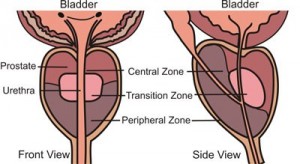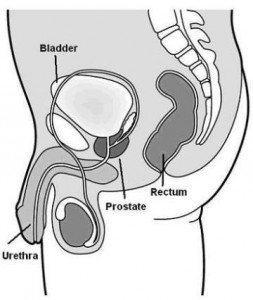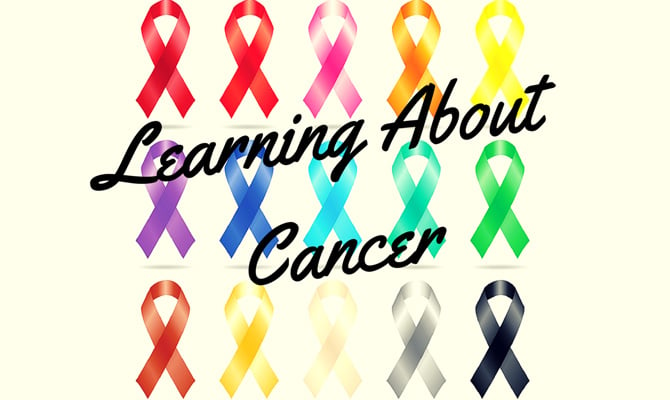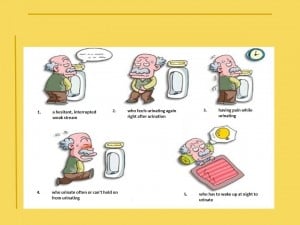Prostate Cancer Usually an adenocarcinoma, that is the gland cancer. It is common after 65 years old. 89.9% are 55 years old and older. It is 9th most common cancer in the world, 2nd most common cause of cancer death. Most men do not have symptoms, do not need treatment and pass on of unrelated causes. Cancer usually spreads to lymph nodes and bone, particularly hip bone.

 SIU School of Medicine – www.siumed.edu Irish Cancer Society – www.cancer.ie – It is walnut shaped gland. – Directly below the bladder (stores urine). – In front of the rectum (buttocks). – Can be felt from the rectum. – 1st 3cm of urethra (tube that passes out urine) is in the gland. – Has a capsule covering the gland and 3 zones
SIU School of Medicine – www.siumed.edu Irish Cancer Society – www.cancer.ie – It is walnut shaped gland. – Directly below the bladder (stores urine). – In front of the rectum (buttocks). – Can be felt from the rectum. – 1st 3cm of urethra (tube that passes out urine) is in the gland. – Has a capsule covering the gland and 3 zones
- Cancer usually starts from the peripheral zone.
- Cancer happens within the capsule.
- Slowly intrudes to urethra and blocks it.
What are the Screening tests available? – There are 2 commonly done screening tests.
- Per Rectal Examination (PRE)
- You will be lying down on your side with your buttocks at the edge of the bed and knees bent to your chest.
- A doctor will insert a finger into your rectum.
- The doctor will make a clock-like motion to feel for the size of the prostate.2.
2. Prostate Serum Antigen (www.cancer.gov )
- Protein produced by prostate gland.
- Widely used to screen for prostate cancer and also to monitor the progress after treatment.
- Normal result is 4.0ng/mL
- If it is raised, there is higher chance of prostate cancer.
PSA screening encouraged yearly if, – Men over 50 years; – Concerned of prostate cancer; – Family history of prostate cancer. PSA is not specific. – Anxiety can cause increased PSA. – Some men with raised PSA might not have prostate cancer. – Does not tell how fast the cancer is growing. What are the risk factors for prostate cancer? – Factors that increases the chances of getting prostate cancer. (American Cancer Society)
- Age more than 65 years old;
- More common in African-American or Caribbean men;
- Family history of prostate cancer;
- High intake of red meat or fat dairy products;
- Obesity;
- Smoking;
- Previous infection of prostate;
- Genetics.
Early Symptoms of Prostate Cancer – http://www.songamstud.co.kr/
Other Early Symptoms – Blood in urine – Pain when urinating – Unable to get an erection Late Symptoms – Back pain or bone pain – Reduced appetite – Loss of weight How is the diagnosis made? Based on the “ American Cancer Society” – Medical history and physical examination; – Transrectal ultrasound (TRUS)
- Uses sound waves to create an image of the prostate on the screen.
- A small probe will be inserted into the rectum.
- Sound waves will enter the prostate and echoes are captured by probe.
- Procedure takes less than 10 minutes.
– Prostate Biopsy
- A procedure where a sample of prostate tissue is removed and looked under a microscope.
- Can be done when doing a TRUS.
- A small, hollow needle will be inserted through wall of rectum.
- This is repeated 8 to 18 times, 12 samples are usually taken.
- Procedure may be painful.
- Results usually takes 1 to 3 days, but may be longer.
- The sample will be graded.
– If there is a spread, the following will be done.
- Bone scan – to see if cancer has reached the bone;
- CT scan – to see if cancer has reached the lymph nodes;
- MRI;
- Lymph node biopsy – lymph nodes will be removed and looked under microscope.
What are the current treatment Options? According to the National Cancer Institute – Watchful Waiting or Active Surveillance
- For older men with no signs and symptoms.
- For men with other medical conditions and cancer found during screening.
- Watchful Waiting
ü Patient’s condition will be closely monitored with no treatment. ü Treatment given when signs or symptom appear or change. ü Treatment is to relief symptoms or improve quality of life.
- Active Surveillance
ü Patient’s condition closely followed with no treatment. ü Treatment given when there are changes in test results. ü Certain investigations will be done – PRE, PSA test, TRUS, to see if cancer is growing. ü Treatment is to cure the cancer. – Surgery
- Patient in good health and tumour is in the prostate gland only.
- Can cause problem getting an erection, leaking of urine or stools and hernia which is a bulge of fat or small intestine.
- Radical prostatectomy
ü Surgery to remove prostate, tissue around it and the ducts that release semen. ü Can be done from abdomen, rectum or urethra (used to pass urine). – Radiation Therapy
- Cancer treatment using high-energy X-rays to kill cancer cells and stop them from growing.
- Depends on type and stage of cancer.
- May increased risk of bladder or gastrointestinal cancer.
– Hormone Therapy
- Removes hormones or blocks the actions of hormones.
- Stops cancer cells from growing.
– Chemotherapy
- Cancer treatment uses drugs to stop growth of cancer cells.
- Can be taken by mouth or injected into blood stream.
What is the prognosis? – If treated early, most patients live more than 5 years Any newer treatments available? – Still being tested.
- Cryosurgery
- High-intensity Focused Ultrasound
- Proton Beam Radiation Therapy
Prepared by: – Ng Shien Yee, Semester 9 Student, International Medical University – A/Prof Rumi Khajotia, Department of Internal Medicine, International Medical University – Sharmini Gangadaran, Academic Services, Clinical School, International Medical University










